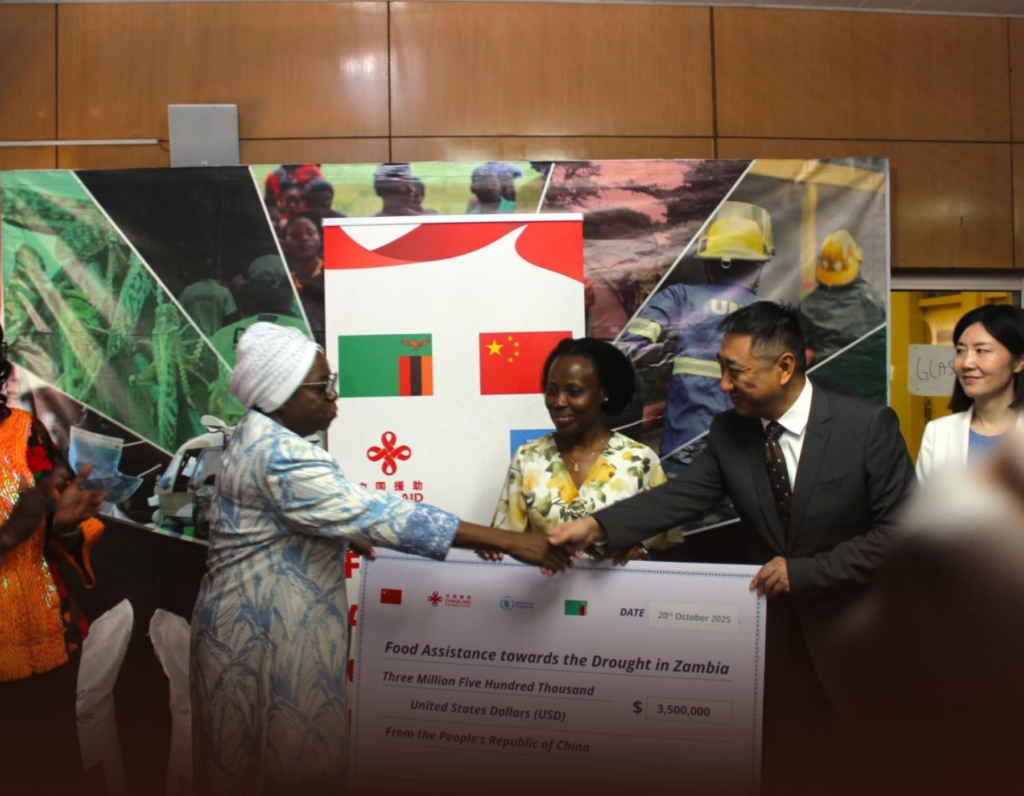In a significant humanitarian gesture, the Chinese government has contributed US$3.5 million through the Global Development and South-South Cooperation Fund to support Zambia’s food security efforts. The contribution will enable Zambia to procure approximately 5,641 metric tonnes of maize locally, which is earmarked to assist about 188,057 people, or around 37,000 households, across drought-affected districts in Southern and Western Provinces over the next three months.
The hand-over ceremony took place in Lusaka and was attended by China’s ambassador to Zambia, Han Jing, along with Zambia’s Vice President Mutale Nalumango, officials from China International Center for Economic and Technical Exchanges (CICETE), and representatives of the World Food Programme (WFP), which will co-implement the program. Ambassador Han described the initiative as a model of China’s evolving development and multilateral cooperation, stating it “strengthens the comprehensive strategic and cooperative partnership between China and Zambia.”
Vice President Nalumango expressed gratitude for the timely support, noting that Zambia is confronting severe drought conditions with nearly 9.9 million people across 84 of its 116 districts affected and called Chinese assistance “a significant relief to communities in crisis.”
This humanitarian injection aligns with a long-standing diplomatic relationship between China and Zambia. Since establishing formal ties in 1964, China has become one of Zambia’s most enduring partners. The two countries have collaborated on major projects such as the TAZARA Railwa – built in the 1970s with Chinese engineering and more recent investments in energy, agriculture and infrastructure.
In recent years China-Zambia cooperation has expanded to include agriculture and trade: Chinese enterprises contributed to Zambia’s “Friendship Farms”, aimed at modernizing maize and wheat production and laying groundwork for future agri-industrial development. The new maize procurement program further builds on that history, combining food relief with local market strengthening and smallholder support, an approach that promises to benefit both vulnerable households and farming communities.
Analysts say the use of local procurement within this Chinese-supported aid program signals a shift toward more sustainable, integrated interventions, where immediate relief, market linkage, and value-creation merge. In a recent report, the WFP highlighted how local maize purchases under the program “will not only feed affected populations but also strengthen market linkages for surplus-producing districts and boost incomes for smallholder farmers.”
Challenges remain: Zambia must ensure that such aid is paired with resilient supply chains, climate-adapted agriculture, and transparent oversight so that relief leads to long-term development outcomes. The Chinese grant, while significant, forms part of a broader Zambia strategy that includes debt restructuring talks with China and infrastructure revitalization projects. In March 2024, China reaffirmed its commitment to cooperate on Zambia’s debt rework, underscoring the multifaceted nature of their partnership.
As drought-affected communities await maize distributions, the Chinese donation becomes a tangible example of cooperation rooted not just in infrastructure, but in humanitarian support and social impact. For Zambia, the gesture advances its food security agenda; for China, it reinforces a narrative of cooperation built on shared prosperity and lasting partnership not simply aid, but strategic connection.





